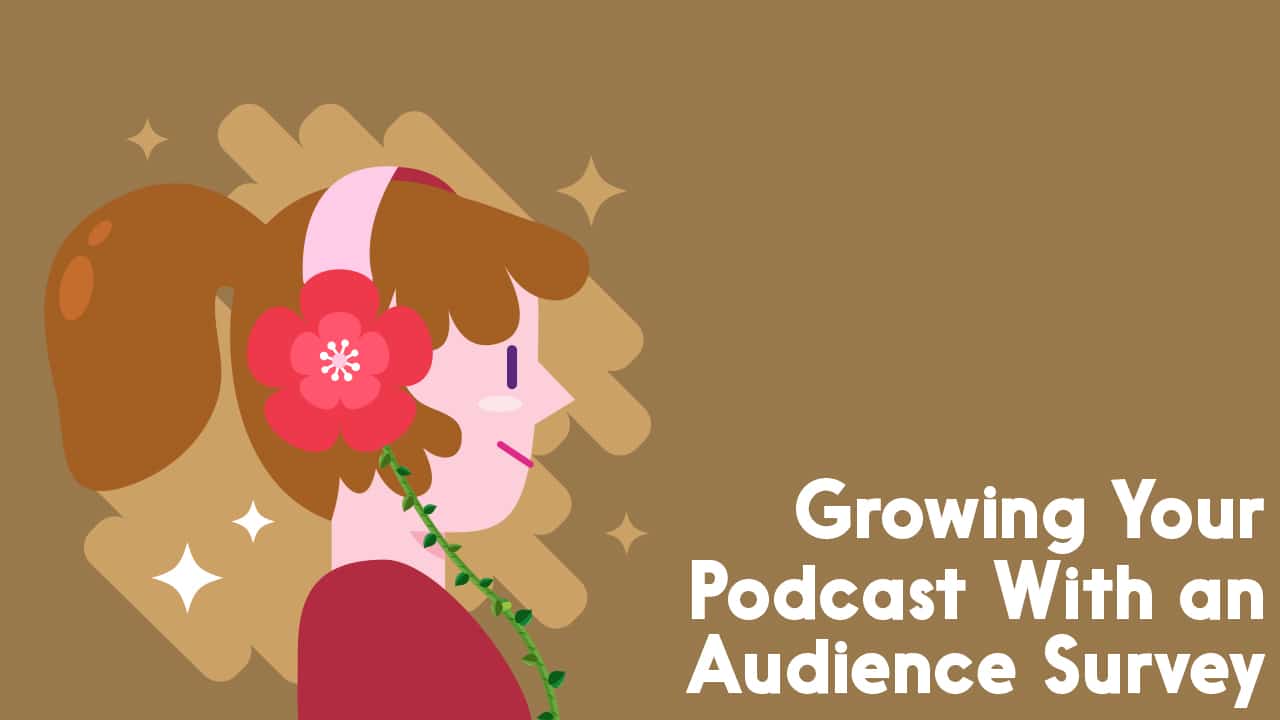Podcast audiences are like gardens. Take care of the plants that you have, and they’ll keep sending up new shoots and flowers. All right, this might not be the best analogy. Still, a podcast survey is an excellent way to increase your audience.
Your current listeners are the best PR team to increase audience growth. Get to know your current listeners. They’ll tell their friends about your podcast. Find out what their interests and habits are. Get them to tell you what they want your podcast to do. This way, you can fine-tune your podcast to increase your audience and reach more listeners.
I’m not suggesting you take each individual listener out for a chat over a cup of coffee (though that would be very nice of you). The best way to get the information about your audience that you need, is with a short and carefully crafted podcast survey.
Podcast Survey Tools For Growth
I like a free tool as much as the next podcaster, so let’s start with a couple of them. And I’ll include one paid option if you want to really ramp up your data gathering.
Google Forms has a gallery of templates which you can use to create a standard type of form. It’s easy to use, and everyone knows the brand, so it’s pretty low-barrier. The look is, for me, a bit dated, but it’s totally adequate for your average survey.
SurveyMonkey is a lot more flexible. It’s a paid product, normally, but the freemium tier will let you make a short podcast survey with ten questions or less, for nothing. If you don’t need to go long, or need any of their other premium options, it could suit well.
Paperform is my final recommendation, for those who want the full power of a paid product. Full flexibility and a range of beautiful templates, you can make a survey that looks great and really draws people in.
One of the best Paperform features is the ability to create what they call a ‘landing form.’ In plain english, it’s a page creator that includes survey elements, so you can build a great looking ‘audience welcome page’ which asks them questions, gets your data, but also gives them a bunch of value through episode guides, downloads, contact info and more. You can build a place where you give as value them as they give to you in filling in their data.
You really don’t want your podcast survey to be longer than ten questions. Your listeners are already giving you their time and mental effort. Ask for a little, and you’ll get a lot.
Multiple-choice questions will get you results that are focused and specific. Open-ended questions can give you results you hadn’t expected. They can also lead listeners to use them as a personal soapbox or open-mic night. Limit the amount of characters responders can use, so they have to keep their response short.
Why Not Run a Voice Survey?
Voice Feedback Surveys are good because they’re low-commitment and novel, the responses are text and audio, and the responses can have more meaning for your podcast than pie charts and bar graphs. A voice survey allows for candour and spontaneity on the part of the respondent. You might have fewer questions per survey, but the responses will be rich with detail and repurposable for your podcast. You can even (with permission) turn them into Q&A episodes on your podcast.
Ease in with Demographic Questions
Simple, basic questions about the responder helps them feel like, “this is easy.” This lets them get used to the podcast survey process, before you ask them opinion questions requiring more thought. These general things that give you an idea of what your audience is like. You probably want to know:
- where they live
- what age range they fall into
- what level of education they have
Knowing where your listeners live helps you make a lot of important decisions. This can help you decide what kind of sponsors to approach (national? local? international?), what conventions to attend, or where to hold live events.
Age and education level give you broad social context. For example, if 90% of your listeners are under age 25, they might not know what a photography darkroom is. If the majority of your listeners have advanced degrees, they might appreciate perks like an e-book, more so than a group that doesn’t enjoy reading.
When it comes to information that’s more personal (ethnicity, gender identity, faith), decide what’s most relevant to your podcast and its growth. People are already hesitant to give out too much personal information over the Internet. Be gentle with personal questions.
Don’t be afraid to add a brief statement mentioning that the purpose of this podcast survey is purely to fine-tune the show for their tastes. Keep the demographic questions fairly broad. If a question feels awkward, then ask yourself what the purpose is of asking this, and how it’s relevant to your podcast.
Opinions about format
Here, you can ask them about the way your show is presented. You can ask them if they prefer interviews, solo talking, or panel discussion. Ask how they feel about the episode length. You can also ask if they prefer to listen to each episode all at once, or if they tend to listen to it in chunks. This gives you some valuable insight. If you have recurring segments, ask if there are parts they look forward to.

What’s in it for your listener?
Here’s where you’ll ask why they listen, and what they get out of it. Unlike broadcast radio or television, people don’t turn on their device and listen to “whatever’s on.” They have to make a choice. Asking why they listen and what it does for them, in different ways, will get answers with different focus.
Ask what they do while listening. Do they commute? Exercise? Cook? Data entry? Close their eyes and give it full attention?
This kind of question helps you know if you need to make sure you can be heard on a crowded train, or if you can afford a subtle multi-layered sound bed. It also tells you a bit about their interests, for when you look for sponsors.
Give them a fill-in-the-blank option, i.e., “I listen to (podcast) because…”
Tell them that you’ll use this information anonymously for social media. If they know they’re your PR team, they may say something interestingly unique.
Ask them about things they’d want to see happen with your podcast. People might throw you long shots, like “Get William Shatner to do a cameo!” for your audio drama, or a live episode from the Jukkasjärvi ice hotel. But it might give you ideas to find a Shatner-esque voice actor, or a winter carnival tie-in.
Discovery
Always ask how your listeners found out about the podcast. Did they find out about the show through social media, word of mouth, or maybe another podcast? Did they find out through paid advertising? Did someone write a tweet or Facebook status recommending your work?
This helps you find out what means of promoting your show are working, and which are getting swept under the rug. You can focus more on the ones that work.
Ask your listeners what other podcasts they listen to. This gives you a clearer sense of their taste. It also gives you ideas for cross-marketing with other podcasts.
Dislikes
Eventually, you’ll have to ask what they don’t like about your podcast. Are there sections that they skip? How about parts where they find themselves not paying attention? Is any of the information confusing? What about the sound production?
Podcast Survey Showtime
Keep your audience survey posted and open long enough to be able to mention it at the end of at least 3 episodes. Make sure it’s heard! Mention it on your podcast’s social media and web site. Use a short link system like PrettyLink to make a clear link to your survey. It’ll look something like yourpodcast.com/survey, and it’s easy to repeat in the recording stage.
Offer incentives to your listeners, like a free download for everyone who participates. If they get something for their time, like a mobile or desktop wallpaper, or a pdf of content that complements your podcast, they’ll be more inclined to spend time on your podcast survey.
Another enticement is a prize drawing for one randomly selected participant. Something like an Amazon gift card is easy to deliver.
If you have a very few listeners, but you know some people who do listen, ask those people directly. They’ll appreciate being asked, and knowing that they’re important to you.
Now that you’ve got podcast survey data, what’s next?
It’s always nice to get a pat on the back. When you look at the results of the podcast survey, set aside your ego. Pretend it’s someone else’s show. The podcast survey results can help you create more content in the future, or tie-in products or perks.
Once you’ve gathered these responses, be sensible. If people mention something specific that you can change (“the theme music goes on for three minutes and that’s too long”), then think about changing it.
If it’s not changeable (“women have shrill voices! history is boring!”), then don’t worry about it. Unless, of course, you get a lot of feedback about it. Then, talk with other podcast creators that you trust.
Find out if they hear what your audience mentioned. For example, a comment about “shrill voice” sound might just be an indication of a need for some gain adjustment.
In a recent blog post about surveys and polls, marketing wizard Seth Godin said, “even asking someone a thoughtful question about their satisfaction can increase it.” Podcast surveys aren’t just about getting the word out. They’re about looking at what you’re doing right, and planning what you can do better, to engage the listeners you have.
With that accomplished, your listeners will spread the word for you.
We’re chock-full of good strategies about how to promote your podcast, engage listeners, and get noticed. Plus, if you join Podcraft Academy, you can work with a community of like minded creatives, watch videos, download materials, get personal help, and participate in live Q& A sessions to fine-tune your hard work. Join us!
